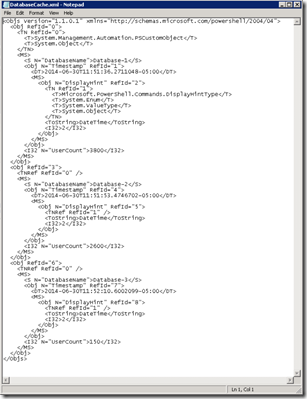Caching Objects in PowerShell – Part 1
In the first section of this two part series, I will discuss caching objects to disk in PowerShell, and reading the cache back into memory. I recently came up with this solution at a customer site where I was running a script as a scheduled task and needed some data to persist after the task was complete. I use this to track different errors and how many times I’ve encountered those errors; as well as caching data from complex (read: expensive) LDAP queries.
So let’s take a look at something LDAP we could cache. Let’s say I have an array of objects in memory representing Exchange databases with current number of mailboxes (I like to query LDAP for this data - see this post). The objects could be anything – but the concept is straightforward as we will cache the data to disk using XML. For this example, let’s create some fake data with custom PSObjects. I chose to use different types (string, int, datetime) on purpose here to show how this really shines compared to using something like export/import –csv, which only recognizes strings without doing type casting or conversion.
$DBs = @()
$DBs += New-Object psobject -Property @{DatabaseName="Database-1"; UserCount = 3800; Timestamp=(Get-Date)}
$DBs += New-Object psobject -Property @{DatabaseName="Database-2"; UserCount = 2600; Timestamp=(Get-Date)}
Once the array of custom objects is created, we can simply export it using the built in Export-Clixml cmdlet.
$DBs | Export-Clixml .\DatabaseCache.xml
This will save all of our data to an XML file and retain associated type information, etc. Here is what the raw XML data looks like.
To use this data again, simply use the Import-Clixml cmdlet and you will have the exact same array of objects you previously exported. Stay tuned as my next post will show some examples of how to update the cache.

